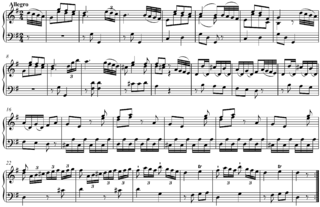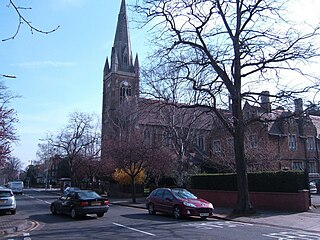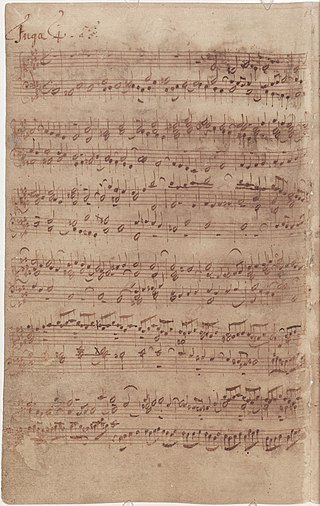Related Research Articles

In classical music, a fugue is a contrapuntal, polyphonic compositional technique in two or more voices, built on a subject that is introduced at the beginning in imitation, which recurs frequently throughout the course of the composition. It is not to be confused with a fuguing tune, which is a style of song popularized by and mostly limited to early American music and West Gallery music. A fugue usually has three main sections: an exposition, a development, and a final entry that contains the return of the subject in the fugue's tonic key. Fugues can also have episodes—parts of the fugue where new material is heard, based on the subject—a stretto, when the fugue's subject "overlaps" itself in different voices, or a recapitulation. A popular compositional technique in the Baroque era, the fugue was fundamental in showing mastery of harmony and tonality as it presented counterpoint.
Subject may refer to:
Johann Pachelbel was a German composer, organist, and teacher who brought the south German organ schools to their peak. He composed a large body of sacred and secular music, and his contributions to the development of the chorale prelude and fugue have earned him a place among the most important composers of the middle Baroque era.

The Art of Fugue, or The Art of the Fugue, BWV 1080, is an incomplete musical work of unspecified instrumentation by Johann Sebastian Bach. Written in the last decade of his life, The Art of Fugue is the culmination of Bach's experimentation with monothematic instrumental works.

Ludwig van Beethoven's Piano Sonata No. 29 in B♭ major, Op. 106 is a piano sonata that is widely viewed as one of the most important works of the composer's third period and among the greatest piano sonatas of all time. Completed in 1818, it is often considered to be Beethoven's most technically challenging piano composition and one of the most demanding solo works in the classical piano repertoire. The first documented public performance was in 1836 by Franz Liszt in the Salle Erard in Paris to an enthusiastic review by Hector Berlioz.

In music, a subject is the material, usually a recognizable melody, upon which part or all of a composition is based. In forms other than the fugue, this may be known as the theme.
A ricercar or ricercare is a type of late Renaissance and mostly early Baroque instrumental composition. The term ricercar derives from the Italian verb ricercare, which means "to search out; to seek"; many ricercars serve a preludial function to "search out" the key or mode of a following piece. A ricercar may explore the permutations of a given motif, and in that regard may follow the piece used as illustration. The term is also used to designate an etude or study that explores a technical device in playing an instrument, or singing.
In music, especially Western popular music, a bridge is a contrasting section that prepares for the return of the original material section. In a piece in which the original material or melody is referred to as the "A" section, the bridge may be the third eight-bar phrase in a 32-bar form, or may be used more loosely in verse-chorus form, or, in a compound AABA form, used as a contrast to a full AABA section.
In music, the Italian term stretto has two distinct meanings:
- In a fugue, stretto is the imitation of the subject in close succession, so that the answer enters before the subject is completed.
- In non-fugal compositions, a stretto is a passage, often at the end of an aria or movement, in faster tempo. Examples include the end of Franz Liszt's transcendental etude No.10, the end of the last movement of Beethoven's Fifth Symphony; measure 227 of Chopin's Ballade No. 3; measures 16, 17 and 18, of his Prelude No. 4 in E minor; and measure 25 of his Etude Op. 10, No. 12, "The Revolutionary."

The Piano Sonata No. 31 in A♭ major, Op. 110, by Ludwig van Beethoven was composed in 1821 and published in 1822. It is the middle piano sonata in the group of three that he wrote between 1820 and 1822, and is the penultimate of his piano sonatas. Though the sonata was commissioned in 1820, Beethoven did not begin work on Op. 110 until the latter half of 1821, and final revisions were completed in early 1822. The delay was due to factors such as Beethoven's work on the Missa solemnis and his deteriorating health. The original edition was published by Schlesinger in Paris and Berlin in 1822 without dedication, and an English edition was published by Muzio Clementi in 1823.
Attacco, in music, indicates a short phrase, treated as a point of imitation; and employed, either as the subject of a fugue, as a subordinate element introduced for the purpose of increasing the interest of its development, as a leading feature in a motet, madrigal, full anthem, or other choral composition, or as a means of relieving the monotony of an otherwise too homogeneous part-song. The name comes from the Italian attaccare, "to unite" or "to bind together."
Attacco (It.) A 'point' of imitation—that is, any short passage or figure proposed for treatment by imitation. In fugues the attacco is often made from a fragment of the subject or of the andamento, but is sometimes quite independent.
The Passacaglia on DSCH is a large-scale composition for solo piano by the British composer Ronald Stevenson. It was composed between 24 December 1960 and 18 May 1962, except for two sections added on the day of the first performance on 10 December 1963. The composer presented a copy of the score to Dmitri Shostakovich, its dedicatee, at the 1962 Edinburgh Festival.

36 Fugues, sometimes assigned opus number 36, is a cycle of fugues for piano composed by Anton Reicha. It was first published by the composer in 1803 and served as an illustration of a nouveau système Reicha invented for fugue composition. This system involved, among other things, extensive use of polyrhythms, derived from traditional music, and fugal answers on any and all scale degrees, rather than just the dominant, which was standard at the time.

In musical form and analysis, exposition is the initial presentation of the thematic material of a musical composition, movement, or section. The use of the term generally implies that the material will be developed or varied.
Souvenir des Ming is the title of Jeffrey Ching's Fourth Symphony, which was composed in London between 14 January and 29 June 2002, and is in a single large movement lasting about thirty-five minutes. There is a further parenthetical title, Passacaglia and Fugue on Ming dynasty Fragments, which describes the actual thematic content and form of the work. In China the work is known as Minglü huiyin 明律回音.

Johann Sebastian Bach's Prelude and Fugue in D major, BWV 532.2, is a prelude and fugue written for the organ c. 1710, and has an approximate duration of 11+1⁄2 minutes. BWV 532.1 is an earlier version of the Fugue.

The Clavier-Übung III, sometimes referred to as the German Organ Mass, is a collection of compositions for organ by Johann Sebastian Bach, started in 1735–36 and published in 1739. It is considered Bach's most significant and extensive work for organ, containing some of his most musically complex and technically demanding compositions for that instrument.

Prelude and Fugue on a Theme of Vittoria is a work for solo organ composed by Benjamin Britten in 1946. It was commissioned for St Matthew's Church, Northampton and first performed on 21 September 1946, St Matthew's Day, three days after its composition. It uses a theme from a motet by the Spanish composer Vittoria, both in the prelude and as the basis for the fugue. The piece, which lasts about five minutes in performance, has had a mixed reception. One writer has noted the difficulty on finding a suitable organ on which to perform the piece, given the difficulties in finding appropriate registration to meet Britten's requirements. A reviewer of a concert performance in the 1960s called it "a contrived attempt to make bricks without straw", although other commentators have been more favourable about the piece.

Prelude and Fugue in E minor, BWV 548 is a piece of organ music written by Johann Sebastian Bach sometime between 1727 and 1736, during his time in Leipzig. The work is sometimes called "The Wedge" due to the chromatic outward motion of the fugue theme. Unlike most other organ preludes and fugues of Bach, the autograph fair copy of the score survives, though the handwriting changes twenty two measures into the fugue to the hand of Johann Peter Kellner, a likely pupil and acquaintance of Bach who played an important role in the copying of his manuscripts. Because of the work's immense scope, it has been referred to as "a two-movement symphony" for the organ.

The Prelude and Fugue in C-sharp minor, BWV 849, is a pair of keyboard compositions by Johann Sebastian Bach. It is the fourth prelude and fugue in the first book of The Well-Tempered Clavier, a series of 48 preludes and fugues by the composer.
References
- 1 2 3 4 5 Walker, Paul M. "Andamento". Grove Music Online . Oxford University Press.